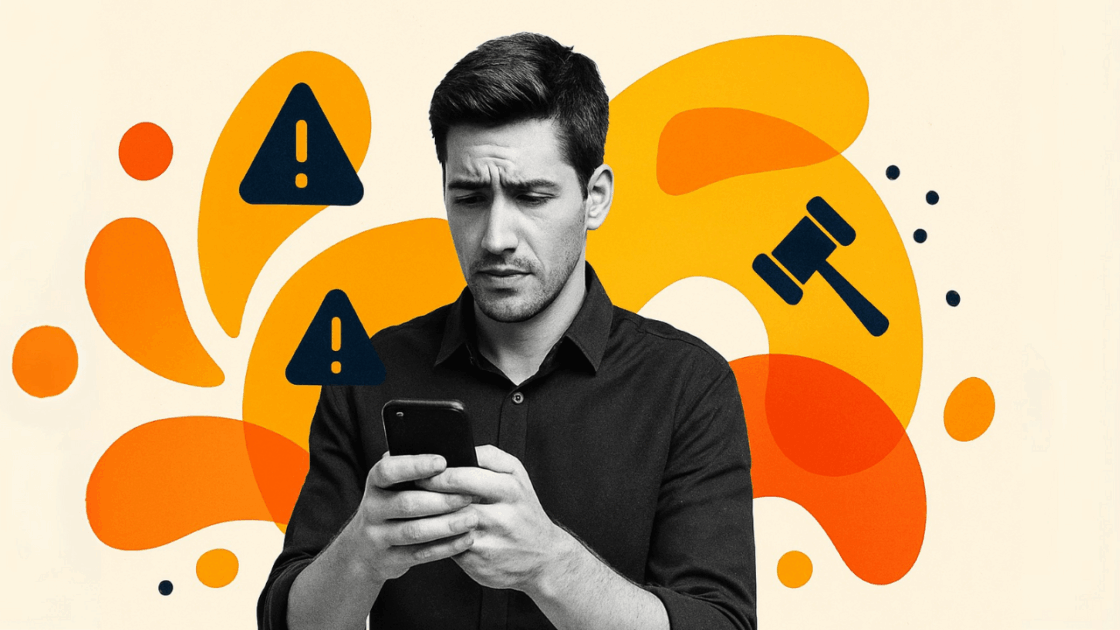The social media legal landscape has dramatically evolved, with recent years bringing unprecedented regulatory changes that are catching businesses and individuals off guard. There are numerous legal traps that people fall into every day on social media without even realizing it – and the stakes have never been higher.
While social media platforms were once considered relatively unregulated spaces, the surge in state legislation and enhanced federal enforcement has created a complex web of compliance requirements. With 12 states having enacted social media laws (though some are currently blocked by court injunctions) and the FTC increasing enforcement actions, ignorance of these laws won’t protect you if you break them – and violations can result in substantial fines and legal consequences.
This regulatory shift impacts everything from how young users can create social media accounts to how companies handle user-generated content and ad revenue.
We don’t want you to get in trouble posting about your next snack or sharing a celebrity’s post so that’s why we’ve put together this comprehensive list of the most commonly broken social media laws and how to avoid breaking them.
Understanding these regulations isn’t just about individual users – social media companies and social media platforms face increasing scrutiny from regulators, making compliance essential for businesses of all sizes. These laws require platforms to obtain parental consent, implement age-appropriate design features, and ensure that online services protect minors from accessing harmful content.

New State Social Media Laws
The biggest development in social media law has been the wave of state legislation targeting platform accountability and minor protection. Twelve states have enacted social media laws (with five currently in effect, four taking effect in 2025, and three blocked by court injunctions), with more expected to follow.
Key state requirements include:
- Age verification systems – Digital service providers must require age verification and verify users ages, not just asking users to confirm their age
- Parental consent mechanisms – Enhanced requirements to obtain parental consent for users under 16 or 18 (depending on state) before allowing minors to open accounts
- Default privacy settings – Online services must set the most restrictive privacy settings as defaults for minor social media accounts
- Content restrictions – Limitations on certain content, advertising specific products to minors, and algorithmic content recommendations
States like Texas, Florida, and Utah have implemented some of the most comprehensive requirements, while other states like Connecticut and Maryland focus primarily on parental consent and data protection. South Carolina and other states are also developing similar frameworks. These state laws go beyond federal protections, creating a patchwork of complexity where platforms are required to age-verify and get parental consent prior to granting minors access to their online services. You should be aware of which state laws apply to your audience if your business has social media profiles or runs ad campaigns.
COPPA Compliance: Beyond the Basics
The Children’s Online Privacy Protection Act (COPPA) is one of the most common federal laws violated in social media. This pre-Communications Decency Act law creates important safeguards for young users. The recent FTC enforcement actions have made it clear that platforms cannot solely depend on age self-reporting when they have actual knowledge that users are under the age of 13, with some going up to federal judge decisions that create significant precedents for social media usage by minors.
COPPA violations are a top compliance concern for social media websites. The most prevalent violation is the lack of adequate age verification processes, in which sites rely solely on user-reported ages without implementing robust verification methods. This is particularly problematic when sites possess actual knowledge that users are under 13 years old, as the FTC has explicitly stated that age confirmation checkboxes do not suffice.
Another critical area where platforms frequently fail is obtaining verifiable parental consent. The law requires platforms to implement systems that genuinely verify a parent’s identity before allowing data collection from children. Most platforms find it difficult to meet this requirement, especially when introducing new features or making substantial changes to their data collection practices that necessitate re-seeking consent.
Data collection and security breaches are also rampant, where sites gather more personal data from children than is required or don’t take sufficient security precautions to safeguard this sensitive information. Privacy notice breaches are also prevalent, where sites don’t offer clear, comprehensible details to parents regarding what information is collected and how it’s being utilized.
The FTC has also greatly increased fines, including recent settlements such as YouTube’s $170 million penalty in 2019 for violating COPPA and TikTok’s $5.7 million settlement in 2019, while Meta paid $5 billion in 2019 for violating privacy laws. Ensure that your platform or marketing efforts do not target children unintentionally without appropriate protections in place.
Ignorance of the terms of service
We all know that just like flossing every day, no one is reading the terms of service for any of the sites they use.
We get it, it’s long and hard to read, almost as if they did it on purpose.
But there are important rules and terms that impact you in the terms of service. Such as “by posting an image, you give other users permission to share the image” on their profiles on that platform so be aware of these policies you’re agreeing to!
A helpful tool for better understanding the terms of service for a site and getting a quick glimpse at important information or dangerous policies, try using the Chrome browser extension Terms of Service; Didn’t Read. The extension gives you information about a website’s terms of service and privacy policies, with ratings and summaries from the www.tosdr.org.
Lack of attribution
When you decide that you want to regram/repost a post on Instagram or on any other social media site, it’s best to use attribution for the original author.
Most photos on social media don’t have a creative commons license allowing public use for everyone, so it’s almost seen as stealing when you use someone else’s photo without their permission or credit. Attribution will protect you from any copyright infringement issues but there are other legal problems that could arise from using someone else’s social media content. Understanding proper social media use and respecting intellectual property rights in social media content is essential for avoiding legal issues.
Copyright law and copyright violation
Copyright violation is one of the most commonly broken social media laws, with major social media platforms processing millions of DMCA takedown requests annually. This issue involves both user-generated content and professional content, raising questions about free speech and First Amendment rights. All photographs are protected by copyright law, whether it’s on Facebook or Google Images or a stock photo that someone else purchased the license for.
When you use someone’s photos on social media, either to regram a post or for a social media influencer marketing campaign, you run the risk of embedded intellectual property infringement.
Isn’t that a mouthful?
Common copyright violations include:
- Reposting without permission – Sharing content from other accounts without explicit consent
- Using stock photos illegally – Using paid stock photos without purchasing the license
- Google Images misconception – Assuming images found on Google are free to use
- Music copyright infringement – Using copyrighted music in videos without licensing
- Profile picture violations – Using someone else’s photo as your profile picture without permission
How to avoid copyright violations:
To avoid this, you need to make sure that you have signed releases from anyone in the picture so their rights to privacy or publicity are not violated.
We mentioned using a stock photo that someone else purchased the rights to, or using a photo from Google Images. The reason this is a copyright violation is that you’re only allowed to use images that you have received permission from the copyright holder directly or a license, such as a Creative Commons license. Anything else where you didn’t take the picture yourself and you’re using the photo is a violation of copyright law.
Best practices for social media companies and individual users focus on proactive content management and legal compliance. The foundation of copyright protection lies in always obtaining written permission before using someone else’s content, regardless of whether it appears to be freely available online. This written permission should be explicit, documented, and retained for potential future legal challenges.
Smart content creators and businesses prioritize using only royalty-free or Creative Commons licensed materials, which provides legal protection while still allowing access to high-quality visual content. Even when legal requirements don’t mandate attribution, crediting original creators builds goodwill, establishes professional relationships, and demonstrates respect for intellectual property rights.
For business accounts, implementing robust content screening processes has become essential. This includes regular audits of posted content, verification of licensing for all visual materials, and staff training on copyright compliance. Many successful companies now use content management systems that automatically flag potentially problematic uploads before they’re published.
If you’re looking for images available with a Creative Commons licence, don’t use Google Images, try using a site like Pixabay or Unsplash.

Sponsored Posts
If you’re a company running an influencer marketing campaign or working with other partners to create sponsored posts, make sure you’re disclosing the fact that it’s sponsored with the correct formatting.
In 2023, the FTC warned 12 online health and diet influencers about inadequate disclosure requirements in sponsored content promoting aspartame, emphasizing that disclosures must be clear and prominent. The FTC’s guidelines for influencer marketing specify that “any disclosure should be placed before the ‘more’ button since many consumers will not click through” and that “certain kinds of hashtags would not be clear disclosures”.
So if you’re doing a sponsored post or working with influencers for a marketing campaign, make sure to read the guidelines the FTC has put together on proper disclosure of sponsored marketing campaigns on social media.
Fraud and astroturfing: A commonly broken social media law
Astroturfing – posting fake reviews on social media or anywhere else online – is one of the most commonly broken laws across social media platforms and is illegal and heavily enforced now more than ever.
This violation of consumer protection laws affects both social media companies and individual businesses, with personal data often used to create fake profiles that post deceptive reviews.
Common types of social media fraud
Social media fraud has evolved into a sophisticated ecosystem of deceptive practices that violate consumer protection laws. Fake reviews and testimonials represent the most widespread form of fraud, where businesses create false customer feedback to artificially boost their reputation. This practice has become so pervasive that platforms like Amazon, Yelp, and Google have invested billions in detection systems.
Bot accounts pose another significant threat, using automated systems to inflate engagement metrics, spread misinformation, and manipulate platform algorithms. These artificial accounts can make businesses appear more popular than they actually are, misleading consumers and violating platform’s terms of service.
The purchase of fake followers has become a multi-million-dollar industry, with businesses buying artificial social media followings to appear more credible to potential customers. Deceptive endorsements involve posting fake influencer recommendations without proper disclosure, while identity theft occurs when fraudsters use someone else’s personal data to create fake accounts for deceptive purposes.
Real-world enforcement examples:
In one case, the state settled for $100,000 with a brand that had instructed its ad agencies to post fake reviews online. This means you can’t make your employees go online and post a review about your company, talking about how great it is, because this is also considered astroturfing.
Social media platforms are increasingly implementing AI detection systems to identify and remove fake accounts, with platforms like Facebook and Instagram removing billions of fake accounts annually.
Legal alternatives for growing reviews:
If you’re looking to grow your online reviews, offer incentives to customers, such as a free product or a discount if they leave a review. If your product is a software or piece of technology, you can list the latest version of the product or software on a site to be beta tested and garner feedback that way. Sites like Betabound offer consumer-sourced beta testing for brands.
Remember: Authentic engagement always trumps fraudulent tactics, and the legal risks of astroturfing far outweigh any short-term benefits.
Age Verification and Platform Compliance: Critical requirements for social media companies
With the new state laws in effect, businesses operating social media platforms or advertising on them must now consider age verification requirements more seriously. This represents one of the most commonly broken laws as many platforms still rely on inadequate self-reporting systems.
Social media companies must now implement robust systems that protect personal data while ensuring compliance with state-specific requirements. These requirements include age appropriate design principles that focus on protecting account holders from harmful content and ensuring social media content is appropriate for different age groups. This goes beyond simply asking users to confirm their age – many states now require “reasonable age verification” which may include:
Technical requirements for social media platforms:
- Integration with third-party age verification services – Professional identity verification systems
- Document verification for certain age groups – Government ID verification for users 13-17
- Parental consent workflows with identity verification – Verified parent/guardian approval systems
- Regular auditing of age verification effectiveness – Ongoing compliance monitoring and reporting
- Enhanced personal data protection – Special safeguards for minor user information
Compliance challenges for social media companies:
The technical and operational burden of compliance can be significant, especially for smaller social media platforms. Some businesses are choosing to restrict their services in certain states rather than implement comprehensive age verification systems.
Major social media platforms like TikTok, Instagram, and Snapchat have invested millions in developing compliant age verification systems, while smaller platforms often struggle with the cost and complexity of implementation. Current law requires platforms to balance social media use restrictions with first amendment protections, while many states now mandate comprehensive age appropriate design standards that protect account holders from inappropriate user generated content.
Data protection requirements
Modern social media platforms must implement comprehensive data protection measures that go far beyond traditional privacy approaches. Personal data minimization has become a core principle, requiring platforms to collect only the information absolutely necessary for their service to function. This means conducting regular audits of data collection practices and eliminating unnecessary data points, particularly for minor users.
Enhanced security measures mandate stronger protection protocols for minor user accounts, including advanced encryption, multi-factor authentication where age-appropriate, and isolated data storage systems. These measures often require significant infrastructure investments but are essential for compliance with state laws.
Parental access rights create new technical and operational challenges, as platforms must build systems that allow parents to review their child’s data, understand how it’s being used, and request deletion when desired. This requires sophisticated user interface design and backend systems that can handle complex family account relationships.
Transparent privacy policies must communicate data collection and use practices in clear, understandable language that parents can easily comprehend. This often means abandoning traditional legal jargon in favor of plain language explanations, visual aids, and interactive tools that help parents understand their rights and choices.
Enforcement Trends and Penalties: The growing cost of breaking social media laws
State attorneys general have become increasingly aggressive in social media enforcement, targeting violations across social media platforms and creating a comprehensive list of social media laws that businesses must follow.
State-by-State Penalty Comparison
| State | Maximum Fine Per Violation | Primary Focus | Implementation Date |
|---|---|---|---|
| Texas | $10,000 | Age verification, parental consent | September 2024 |
| Florida | $10,000 | Platform obligations, content restrictions | July 2025 |
| Connecticut | $5,000 | Parental consent, data protection | July 2023 |
| Utah | $2,500 | Social media curfews, addictive design | October 2024 |
| California | $7,500 | Age-appropriate design, privacy | Currently enjoined |
| Maryland | $5,000 | Privacy protections, parental rights | October 2024 |
Recent enforcement actions targeting social media companies
State attorneys general have launched multi-state investigations into major platforms’ handling of minor data and safety, resulting in significant financial penalties where settlements now commonly reach tens of millions of dollars. Federal judge rulings are increasingly issuing operational requirements that mandate platforms implement specific safety and privacy features rather than just paying fines. Many settlements now include years of ongoing monitoring and compliance reporting requirements that ensure platforms demonstrate ongoing protection of minors from harmful content. This creates long-term oversight burdens for platforms and establishes new precedents for social media use regulation across different states.
Most commonly broken laws and their penalties:
- COPPA violations – Fines up to $43,792 per violation (recently increased from $16,000)
- Copyright violation – DMCA penalties plus potential damages of $150,000 per work
- Personal data breaches – State-specific fines ranging from $1,000 to $10,000 per affected user
- Terms of service violations – Platform bans, account suspensions, and legal action
- Astroturfing and fraud – Consumer protection fines up to $100,000 per incident
Why enforcement is increasing
Social media companies and platforms are no longer treated as neutral intermediaries under the Communications Decency Act. Regulators now view them as publishers responsible for content and user safety, particularly regarding personal data protection. This shift reflects evolving interpretations that may eventually reach the Supreme Court, as these new regulations intersect with first amendment rights and constitutional questions about social media use restrictions.
Business compliance requirements
The regulatory landscape has fundamentally changed how businesses must approach social media compliance. Regular compliance audits are now essential rather than optional, requiring dedicated staff and systematic review processes to ensure digital service providers comply with requirements to obtain parental consent and verify age before allowing minors to create social media accounts. Legal review procedures must be implemented for all social media activities, from content posting to advertising campaigns. Risk assessment frameworks should evaluate potential violations across all platforms where the business maintains a presence. Employee training on social media laws is becoming mandatory for many businesses, with some requiring annual certification programs to understand proper handling of user-generated content and protection of young users from harmful content.
Social media aggregation tools like Juicer help businesses display social media content on their websites while maintaining compliance with these complex regulations. Juicer’s social media moderation features automatically filter inappropriate content, monitor user-generated content across multiple platforms, and ensure that social media displays meet age-appropriate standards. These tools are particularly valuable for businesses that want to showcase social media content on their websites while providing centralized oversight to prevent the display of content that could violate platform terms of service or state regulations.
The days of treating social media laws as suggestions are over. Regular compliance audits and legal reviews are becoming essential for any business with a significant social media presence.
Hopefully, you weren’t breaking too many of these most commonly broken social media laws and now you have the tools and knowledge you need to avoid breaking them in the future. With the rapidly evolving regulatory landscape, staying informed about new requirements and regularly reviewing your social media practices is more important than ever.
Key takeaways for social media companies and individual users:
- Understand that social media platforms are now heavily regulated environments
- Implement proper personal data protection measures, especially for minors
- Stay updated on state-specific requirements and enforcement trends
- Invest in compliance systems rather than facing costly violations




